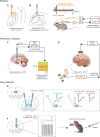Targeting Neural Circuits
- PMID: 27104976
- PMCID: PMC5296409
- DOI: 10.1016/j.cell.2016.03.047
Targeting Neural Circuits
Abstract
Optogenetic methodology enables direct targeting of specific neural circuit elements for inhibition or excitation while spanning timescales from the acute (milliseconds) to the chronic (many days or more). Although the impact of this temporal versatility and cellular specificity has been greater for basic science than clinical research, it is natural to ask whether the dynamic patterns of neural circuit activity discovered to be causal in adaptive or maladaptive behaviors could become targets for treatment of neuropsychiatric diseases. Here, we consider the landscape of ideas related to therapeutic targeting of circuit dynamics. Specifically, we highlight optical, ultrasonic, and magnetic concepts for the targeted control of neural activity, preclinical/clinical discovery opportunities, and recently reported optogenetically guided clinical outcomes.
Copyright © 2016 Elsevier Inc. All rights reserved.
Figures


References
-
- Aravanis A, Wang LP, Zhang F, Meltzer L, Mogri M, Schneider MB, Deisseroth K. An optical neural interface. Journal of Neural Engineering. 2007;4:S143–S156. - PubMed
-
- Berndt A, Yizhar O, Gunaydin LA, Hegemann P, Deisseroth K. Bi-stable neural state switches. Nature Neuroscience. 2008;12:229–34. - PubMed
Publication types
MeSH terms
Substances
Grants and funding
LinkOut - more resources
Full Text Sources
Other Literature Sources

